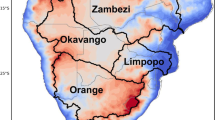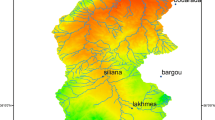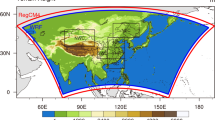Abstract
Projected changes in climatic extremes, compared to the mean climate, exhibit a greater negative impact on the natural environment. Several studies reported that multi-model ensemble approach can improve the reliability of hydro-climatic extreme projection by extracting important information from a large number of general circulation models (GCMs). However, most of the available multi-model assembling methods do not consider both the spatial and temporal variabilities. Thus, this study reflects both the spatial and temporal climate characteristics during multi-model averaging through the Taylor diagram skill metrics. The capability of the proposed multi-model assembling approach was evaluated for reproducing the multitude of climate extreme indices. Moreover, the reliability of a multi-model assembling approach was assessed for preserving the maximum variability of the GCMs output. In general, the results showed that multi-model assembling approach outperformed the individual climate models for reproducing the hydro-climatic extremes; however, it artificially corrupted and narrowed the projected climate extremes variability of the GCMs output. Thus, it is worthwhile to consider both the individual climate models and multi-model ensemble projections toward an improved projection of hydro-climatic extremes. In general, the study proved that the impacts of climate change on the hydro-climatic extremes are more amplified compared to the changes in mean climate. Hence, this study suggests that meaningful efforts should be put in the future to proactively manage the risks of climate extremes.









Similar content being viewed by others
References
Abbaspour KC, Johnson C, Van Genuchten MT (2004) Estimating uncertain flow and transport parameters using a sequential uncertainty fitting procedure. Vadose Zone J 3(4):1340–1352
Arnold JG, Srinivasan R, Muttiah RS, Williams JR (1998) Large area hydrologic modeling and assessment part I: model development. JAWRA Journal of the American Water Resources Association 34(1):73–89
Dai A (2011) Drought under global warming: a review. Wiley Interdiscip Rev Clim Chang 2(1):45–65
Giorgi F, Mearns LO (2002) Calculation of average, uncertainty range, and reliability of regional climate changes from AOGCM simulations via the “reliability ensemble averaging” (REA) method. J Clim 15(10):1141–1158
Giorgi F, Coppola E, Raffaele F, Diro GT, Fuentes-Franco R, Giuliani G, Mamgain A, Llopart MP, Mariotti L, Torma C (2014) Changes in extremes and hydroclimatic regimes in the CREMA ensemble projections. Clim Chang 125(1):39–51
Kumar A, Mitra A, Bohra A, Iyengar G, Durai V (2012) Multi-model ensemble (MME) prediction of rainfall using neural networks during monsoon season in India. Meteorol Appl 19(2):161–169
Mohammed R, Scholz M (2019) Climate variability impact on the spatiotemporal characteristics of drought and Aridityin arid and semi-arid regions. Water Resour Manag 33(15):5015–5033
Moriasi DN, Arnold JG, Van Liew MW, Bingner RL, Harmel RD, Veith TL (2007) Model evaluation guidelines for systematic quantification of accuracy in watershed simulations. Trans ASABE 50(3):885–900
Murphy JM, Sexton DM, Barnett DN, Jones GS, Webb MJ, Collins M, Stainforth DA (2004) Quantification of modelling uncertainties in a large ensemble of climate change simulations. Nature 430(7001):768–772
Nash JE, Sutcliffe JV (1970) River flow forecasting through conceptual models part I—A discussion of principles. J Hydrol 10(3):282–290
Palmer T, Alessandri A, Andersen U, Cantelaube P, Davey M, Delécluse P, Déqué M, Diez E, Doblas-Reyes FJ, Feddersen H (2004) Development of a European multimodel ensemble system for seasonal-to-interannual prediction (DEMETER). Bull Am Meteorol Soc 85(6):853–872
Raftery AE, Gneiting T, Balabdaoui F, Polakowski M (2005) Using Bayesian model averaging to calibrate forecast ensembles. Mon Weather Rev 133(5):1155–1174
Sansom PG, Stephenson DB, Ferro CA, Zappa G, Shaffrey L (2013) Simple uncertainty frameworks for selecting weighting schemes and interpreting multimodel ensemble climate change experiments. J Clim 26(12):4017–4037
Seo SB, Kim Y-O, Kim Y, Eum H-I (2018) Selecting climate change scenarios for regional hydrologic impact studies based on climate extremes indices. Clim Dyn:1–17
Sillmann J, Kharin V, Zwiers F, Zhang X, Bronaugh D (2013) Climate extremes indices in the CMIP5 multimodel ensemble: part 2. Future climate projections. J Geophys Res Atmos 118(6):2473–2493
Smakhtin VU (2001) Low flow hydrology: a review. J Hydrol 240(3–4):147–186
Stéfanon M, Martin-StPaul NK, Leadley P, Bastin S, Dell’Aquila A, Drobinski P, Gallardo C (2015) Testing climate models using an impact model: what are the advantages? Clim Chang 131(4):649–661
Stocker TF, Qin D, Plattner G-K, Tignor MM, Allen SK, Boschung J, Nauels A, Xia Y, Bex V, Midgley PM (2014) Climate change 2013: the physical science basis. Contribution of working group I to the fifth assessment report of IPCC the intergovernmental panel on climate change, Cambridge University Press
Taylor KE (2001) Summarizing multiple aspects of model performance in a single diagram. J Geophys Res Atmos 106(D7):7183–7192
Tegegne G, Kim Y-O (2020) Strategies to enhance the reliability of flow quantile prediction in the gauged and ungauged basins. River Res Appl:1–11. https://doi.org/10.1002/rra.3603
Tegegne G, Kim YO, Lee JK (2019) Spatiotemporal reliability ensemble averaging of multimodel simulations. Geophys Res Lett 46(21):12321–12330
Tegegne G, Melesse AM, Worqlul AW (2020) Development of multi-model ensemble approach for enhanced assessment of impacts of climate change on climate extremes. Sci Total Environ 704:135357
Van Loon AF, Stahl K, Di Baldassarre G, Clark J, Rangecroft S, Wanders N, Gleeson T, Van Dijk AI, Tallaksen LM, Hannaford J (2016) Drought in a human-modified world: reframing drought definitions, understanding, and analysis approaches. Hydrol Earth Syst Sci 20(9):3631–3650
Van Vuuren DP, Edmonds J, Kainuma M, Riahi K, Thomson A, Hibbard K, Hurtt GC, Kram T, Krey V, Lamarque J-F, Masui T, Meinshausen M, Nakicenovic N, Smith SJ, Rose SK (2011) The representative concentration pathways: an overview. Clim Chang 109(1–2):5–31
Vavrus SJ, Notaro M, Lorenz DJ (2015) Interpreting climate model projections of extreme weather events. Weather Clim Extremes 10:10–28
Velázquez J, Schmid J, Ricard S, Muerth M, St-Denis BG, Minville M, Chaumont D, Caya D, Ludwig R, Turcotte R (2013) An ensemble approach to assess hydrological models’ contribution to uncertainties in the analysis of climate change impact on water resources. Hydrol Earth Syst Sci 17(2):565–578
Viney NR, Bormann H, Breuer L, Bronstert A, Croke BF, Frede H, Graeff T, Hubrechts L, Huisman JA, Jakeman AJ (2009) Assessing the impact of land use change on hydrology by ensemble modelling (LUCHEM) II: ensemble combinations and predictions. Adv Water Resour 32(2):147–158
Wang G, Wang D, Trenberth KE, Erfanian A, Yu M, Bosilovich MG, Parr DT (2017) The peak structure and future changes of the relationships between extreme precipitation and temperature. Nat Clim Chang 7(4):268–274
Zhang X, Alexander L, Hegerl GC, Jones P, Tank AK, Peterson TC, Trewin B, Zwiers FW (2011) Indices for monitoring changes in extremes based on daily temperature and precipitation data. Wiley Interdiscip Rev Clim Chang 2(6):851–870
Author information
Authors and Affiliations
Corresponding author
Ethics declarations
Conflict of Interests
The authors declare that there is no conflict of interests regarding the publication of this paper.
Additional information
Publisher’s Note
Springer Nature remains neutral with regard to jurisdictional claims in published maps and institutional affiliations.
Rights and permissions
About this article
Cite this article
Tegegne, G., Melesse, A.M. Multimodel Ensemble Projection of Hydro-climatic Extremes for Climate Change Impact Assessment on Water Resources. Water Resour Manage 34, 3019–3035 (2020). https://doi.org/10.1007/s11269-020-02601-9
Received:
Accepted:
Published:
Issue Date:
DOI: https://doi.org/10.1007/s11269-020-02601-9




